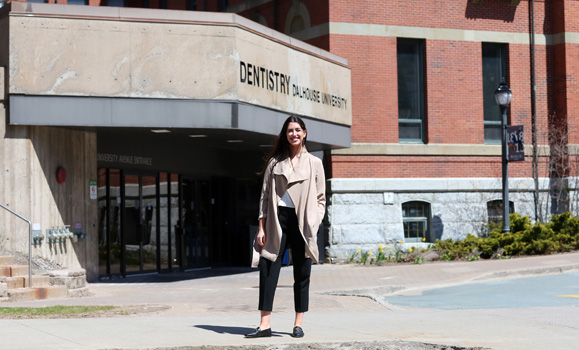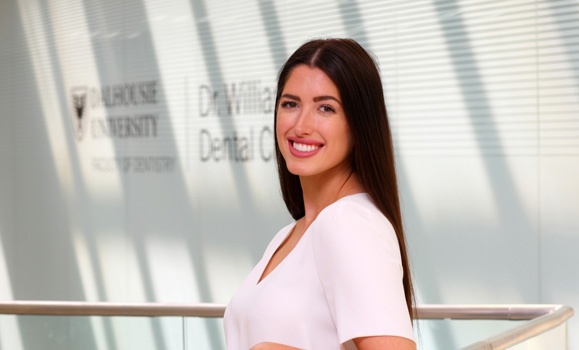This article is part of a series focusing on the grads of the Dalhousie Class of 2019. Spring Convocation kicked off May 10 in Truro, with Halifax ceremonies from May 27 to June 1. Read all our profiles here, and for more information visit the Convocation website.
Katherine Curry (DDS’19) says that as soon as her hand touched the drill, she knew dentistry was the right choice of profession for her. What she didn’t know then was that a challenging surgical speciality – embarked upon by relatively few women – would beckon.
Katherine’s path could easily have taken a different turn. Her father, Dr. Phillip Curry, is an alumnus of Dalhousie’s Faculty of Medicine and a practicing ear, nose, and throat doctor in the family’s home town of Sydney, Nova Scotia. Katherine’s sister will also graduate from Dal as a doctor one day before Katherine receives her diploma on the stage of the Rebecca Cohn Auditorium. Katherine herself studied neuroscience at Dal — a first degree that many aspiring medical students take — prior to starting her studies in the Faculty of Dentistry.
But dentistry also intrigued her and Katherine had a couple of friends who were already studying dentistry who gave her insights into the program. And as someone who enjoys painting and drawing, the “art” side of dentistry also had a strong appeal.
She chose dentistry.
Katherine admits Dal has “been home for me for a while”. But that doesn’t mean she didn’t scan the horizon for the best place to pursue her dentistry studies. “I looked at other universities and was offered a place elsewhere,” she says, “but I realized that Dal offers the best clinical program. You are hands on early in the program, which does a lot for your competence and confidence. And the faculty members here go above and beyond to teach us.”
Receiving her Doctor of Dentistry degree on May 28 will be just another step on what is becoming a much longer journey for Katherine. On June 1, she will become the first student to embark on a new internship in Oral Maxillofacial Surgery (OMFS) at the Victoria General (VG) Hospital. Working under the direction of Dr. Jean-Charles Doucet, an OMFS surgeon who also teaches in the Dal Faculty of Dentistry, her goal is to gain more knowledge and experience before applying to one of Canada’s five English-speaking OMFS programs, of which Dal is one.
The challenge of OMFS
If becoming a dentist is like a 10k run — an undergraduate degree followed by four years of dentistry studies — becoming an oral and maxillofacial surgeon is a full marathon: candidates must graduate with a DDS degree and then complete an OMFS residency, which may include medical school. It’s a commitment of at least a further four to six years.
Although women make up at least half of the graduating classes at most dental schools, in the U.S., only about 15 per cent of the students in OMFS training programs are women.
Katherine started to realize that OMFS could be in her future during her second year of DDS studies. “I really enjoyed restorative work, particularly crowns, and our second-year course on systemic pathology appealed to me. I also discovered that I have a great interest in anaesthesia.”
Testing the water
Once the idea took hold, Katherine seized every opportunity to gain both knowledge and experience in the field of OMFS. In the summer after her second year, she carried out research at the VG Hospital with Dr. JC Doucet and OMFS resident Dr. Matthew Fay on steroid dosing in Canada, particularly after orthognathic surgery.
“I was able to shadow the surgeons in the clinic, observe procedures, and gain a real sense of the scope of practice for an OMFS surgeon. That research also gave me the material for my third-year Table Clinic poster and confirmed my interest in exploring a career in OMFS.”
The quest to learn all she could about the OMFS specialty began in earnest. After her third-year exams, instead of enjoying well-deserved break before the start of summer clinic, Katherine headed to Western University to take advantage of a one-week externship. It enabled her to work with OMFS surgeons (some of whom were Dal dentistry alumni), observe the work of the clinics, and gain exposure to the program.

After the summer clinic — again, with no break — she spent two weeks on another externship at the University of Toronto, dividing her time between Mount Sinai and Sunnybrook Hospital.
“This was really good experience for me. I was able to work with first-year residents in the cadaver lab and learn the necessary techniques. I was also able to observe trauma surgery. It really solidified my interest in this area.”
In addition to the externships, Katherine also sent an abstract on her research to the Canadian Oral and Maxillofacial Surgery Association for its annual meeting in Montreal in May 2018. To her delight, she was chosen to give a 10-minute poster presentation — the only dental student to be selected.
It was the same story for the American Association of Oral and Maxillofacial Surgeon conference in October 2018. At both events she “saw as much as I could. I went to talks, events, and spoke with OMFS surgeons. It was all getting more and more interesting for me.”
In her final year of dentistry school, Katherine was able to pursue an OMFS elective. It enabled her to spend one afternoon a week at the VG, sitting in on patient consultations, watching procedures in the operating room, and gaining more understanding and knowledge.
“I’ve really had a unique experience through Dal and the VG hospital,” she says. “I’ve been able to see a tremendous amount, and I’ve had a lot of encouragement and guidance.”
Fueled by passion
Katherine appreciates the reasons why the number of women in OMFS is comparatively low. “It can be a tricky career if you want a family and a balance between work and life. Being on call is part of the job. But I believe you can manage to do anything if you are passionate about it.”
And Katherine is certainly passionate about the career she has worked so hard to learn about and understand.
When asked what appeals to her about oral and maxillofacial surgery, Katherine says it’s the high level of technique and finesse required, combined with the impact an OMFS surgeon can have on people’s lives. “It could be helping someone with their appearance, such as correcting a cleft lip, or helping someone to function better, for example to be able to chew properly. Then there are car crashes and other traumas which give you the chance to help someone look like themselves again. If you want to do extra training, you can learn more about oral cancer and pathology. You can pursue different specialist avenues or stay more general. I expect my interest will evolve as I learn more.”
It’s a formula that has helped Katherine figure out her next step so far.

